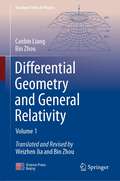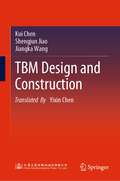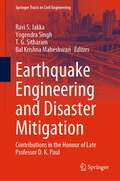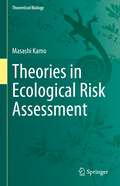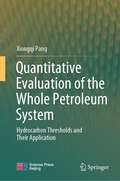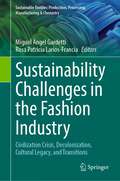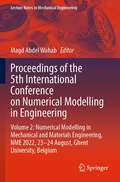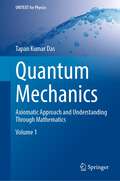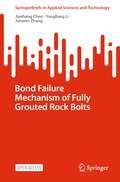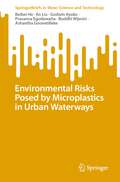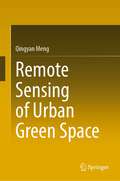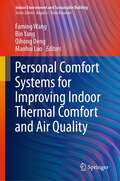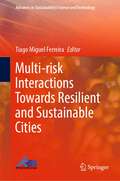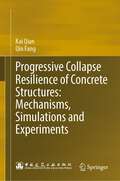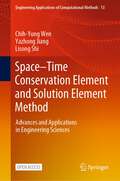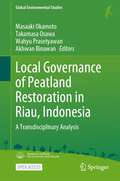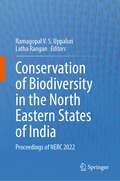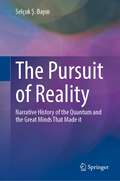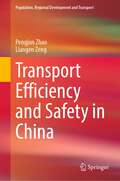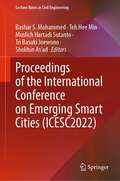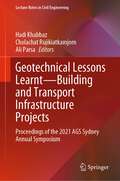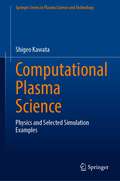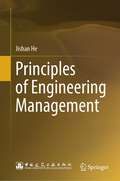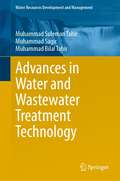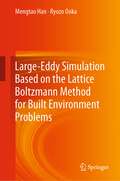- Table View
- List View
Differential Geometry and General Relativity: Volume 1 (Graduate Texts in Physics)
by Canbin Liang Bin ZhouThis book, the first in a three-volume set, explains general relativity using the mathematical tool of differential geometry. The book consists of ten chapters, the first five of which introduce differential geometry, which is widely applicable even outside the field of relativity. Chapter 6 analyzes special relativity using geometric language. In turn, the last four chapters introduce readers to the fundamentals of general relativity. Intended for beginners, this volume includes numerous exercises and worked-out example in each chapter to facilitate the learning experience. Chiefly written for graduate-level courses, the book’s content will also benefit upper-level undergraduate students, and can be used as a reference guide for practicing theoretical physicists.
TBM Design and Construction
by Kui Chen Shengjun Jiao Jiangka WangThis book comprehensively covers the latest technology of TBM's structure and working principle, selection and adaptability design, cutter head design, construction organization and risk control and discusses typical domestic and global case studies on different periods of major TBM projects. Through detailed data and accurate charts, it offers operational guidance with high empirical value. This book is suitable for design, manufacturing, project management, construction and civil and mechanical engineering in the field of TBM technology.
Earthquake Engineering and Disaster Mitigation: Contributions in the Honour of Late Professor D. K. Paul (Springer Tracts in Civil Engineering)
by Ravi S. Jakka Yogendra Singh T. G. Sitharam Bal Krishna MaheshwariThis book has been brought out in remembrance of Prof. DK Paul who has contributed immensely to the domain of Earthquake Engineering and Earthquake Disaster Mitigation. Prof. Paul was a leading authority in this field and has made significant contributions in Earthquake Resistant Analysis as well as Design of various special structures, which resulted in earthquake disaster reduction in India. This book comprises recent diverse topics on earthquake engineering and disaster mitigation. The chapters are of interest to readers, as the different chapters will elaborate popular topics on various aspects of earthquake engineering and disaster management. Substantial research work has been carried out in the domain of earthquake engineering for understanding the underlying phenomena as well as to attain relevance in mitigating disaster. Under overarching umbrella of earthquake engineering and technology, systematic categorization of various ongoing research details pertaining to earthquake engineering and disaster management has been introduced in this book. The chapters appended in this book not only comprise detailed understanding of the responses of soil and structure under the implications of seismic loading but also address some of the innovative ways to cater the implications of severe loading conditions. Further, this book also introduces specific case studies pertaining to various regions of India, which will aid the readers to attain a detailed idea about the seismic aspects of those regions in order to undergo further research. This also aids in mitigating potential hazards due to future earthquakes in terms of taking proper remedial measures. The appended chapters comprise in-depth knowledge about several aspects on earthquake engineering such as nonlinear seismic response of both superstructures and embedded structures, design spectrum, amplification prediction, simulation with the aid of stochastic approaches, seismic performance of structures as well as earthquake induced disasters. The aforementioned wide-ranging topics pertaining to earthquake engineering and disaster management aid in substantial development in futuristic research and employ innovative ways to cater the needs of mitigating disasters. All the chapters consist of proper illustrations and tables which makes it easy to comprehend the vital concepts for the readers as well as aids in implementing new aspects in the field in addition to classroom learning.
Theories in Ecological Risk Assessment (Theoretical Biology)
by Masashi KamoThis book introduces various mathematical models used in ecological risk assessment, primarily discussing models used in hazard assessment. The book aims to link ecology and conservation biology with risk assessments, bringing together the knowledge of ecotoxicology and ecology for effective risk assessment. The first part describes population-level assessment in ecological risk assessment. The chapters cover current methodologies for ecological risk assessment, individual-level assessment, population dynamics models for population-level assessment, case studies, mathematical models for population extinctions, the derivation of mean time to extinction (MTE) and their case studies. The second part of the book discusses the mathematical models involved in hazard assessments. It introduces the method of risk assessment using species sensitivity distributions (SSDs), hazard assessment of metals, chemical mixtures using the Michaelis-Menten equation, basic elements of statistics and related topics. Expected readers are risk assessors in governments and public sectors, students and young researchers interested in environmental science. The book is made accessible and easy to follow by beginners in mathematical biology and theoretical ecology.
Quantitative Evaluation of the Whole Petroleum System: Hydrocarbon Thresholds and Their Application
by Xiongqi PangThis book introduces a complete quantitative evaluation system of the Whole Petroleum System (WPS) on theory and expounds the correlation and difference between conventional and unconventional oil and gas reservoirs and resources, with large number of well-prepared charts and novel expressions. It has important guiding significance for the exploration and development of conventional and unconventional oil and gas all over the world and provides valuable insights for reader with an interest in petroleum geology.
Sustainability Challenges in the Fashion Industry: Civilization Crisis, Decolonization, Cultural Legacy, and Transitions (Sustainable Textiles: Production, Processing, Manufacturing & Chemistry)
by Miguel Ángel Gardetti Rosa Patricia Larios-FranciaFashion, and the growth of fashion, are presented as the manifestation of a process of civilization, within a capitalist culture (capital understood as material possessions) that has become global and imperialist, of which - in an economic sense - the industry (or the fashion system?) functions as one of its main instruments of exploitation. And with respect to design, Arturo Escobar said: "Can design detach itself from its roots in modernist practices of unsustainability and defuturization and reorient itself towards other commitments, practices, narratives and ontological enactions? Moreover, can design be part of the toolkit for the transition to the pluriverze (i.e. a world in which many worlds can fit)?" This book presents the importance of cultural sustainability in the textiles and fashion industry, decolonizing fashion system and promotes the design for transitions.
Proceedings of the 5th International Conference on Numerical Modelling in Engineering: Volume 2: Numerical Modelling in Mechanical and Materials Engineering, NME 2022, 23–24 August, Ghent University, Belgium (Lecture Notes in Mechanical Engineering)
by Magd Abdel WahabThis book gathers outstanding papers on numerical modeling in Mechanical Engineering (Volume 2) as part of the 2-volume proceedings of the 5th International Conference on Numerical Modeling in Engineering (NME 2021), which was held in Ghent, Belgium, on August 23–24, 2022. The overall objective of the conference was to bring together international scientists and engineers in academia and industry from fields related to advanced numerical techniques, such as the finite element method (FEM), boundary element method (BEM), isogeometric analysis (IGA), and their applications to a wide range of engineering disciplines. This book addresses numerical simulations of various mechanical and materials engineering industrial applications such as aerospace applications, acoustic analysis, bio-mechanical applications, contact problems and wear, heat transfer analysis, vibration and dynamics, transient analysis, nonlinear analysis, composite materials, polymers, metal alloys, fracture mechanics, fatigue of materials, creep, mechanical behavior, micro-structure, phase transformation, and crystal plasticity. The book is intended for academics, including graduate students and researchers, as well as industrial practitioners working in the numerical modeling in mechanical engineering topics.
Quantum Mechanics: Axiomatic Approach and Understanding Through Mathematics (UNITEXT for Physics)
by Tapan Kumar DasThis book provides a clear understanding of quantum mechanics (QM) by developing it from fundamental postulates in an axiomatic manner, as its central theme. The target audience is physics students at master’s level. It avoids historical developments, which are piecemeal, not logically well knitted, and may lead to misconceptions. Instead, in the present approach all of QM and all its rules are developed logically starting from the fundamental postulates only and no other assumptions.Specially noteworthy topics have been developed in a smooth contiguous fashion following the central theme. They provide a new approach to understanding QM. In most other texts, these are presented as disjoint separate topics. Since the reader may not be acquainted with advanced mathematical topics like linear vector space, a number of such topics have been presented as “mathematical preliminary.” Standard topics, viz. derivation of uncertainty relations, simple harmonic oscillator by operator method, bound systems in one and three dimensions, angular momentum, hydrogen-like atom, and scattering in one and three dimensions, are woven into the central theme.Advanced topics like approximation methods, spin and generalized angular momenta, addition of angular momenta, and relativistic quantum mechanics have been reserved for Volume II.
Bond Failure Mechanism of Fully Grouted Rock Bolts (SpringerBriefs in Applied Sciences and Technology)
by Jianhang Chen Yongliang Li Junwen ZhangThe purpose of writing this book is to provide the latest research findings in ground control techniques in mining engineering, especially the rock bolting techniques. Since rock bolts are widely used in mining engineering and civil engineering, they are significant in guaranteeing the safety of underground openings. However, instability issues still occur with the rock bolting technique. Therefore, it is valuable to understand the exact load transfer mechanism of rock bolts. This book summarised the recent research work regarding rock bolting conducted by the authors. It is valuable for the readers to fully understand the reinforcing mechanism of fully grouted rock bolts. This book focuses on the bond failure mode of fully grouted rock bolts, which is the most widely encountered failure mode in rock bolting. Different investigation approaches are used in this book, including numerical simulation, analytical modelling and experimental tests. Therefore, this book conducts a comprehensive study to reveal the bond failure process of fully grouted rock bolts. Moreover, it reveals the corresponding bond failure mechanism. Therefore, it helps the reads to fully understand the bond failure mechanism of rock bolting. Moreover, it helps the readers to develop new approaches and methods to prevent failure of the rock bolting system.This is an open access book.
Environmental Risks Posed by Microplastics in Urban Waterways (SpringerBriefs in Water Science and Technology)
by Beibei He An Liu Godwin Ayoko Prasanna Egodawatta Buddhi Wijesiri Ashantha GoonetillekeThis book presents comprehensive knowledge regarding the spatial and temporal distributions, influential factors, interactions with coexisting contaminants, migration behavior, and environmental risk posed by microplastics (MPs) in urban waterways. It provides a novel theoretical approach for the combined risks from MPs and coexisting contaminants, and advanced three-dimensional modeling techniques for different MPs’ dispersal and transport behaviors in urban waterways. Additionally, this book presents a scientifically robust investigation on the correlations between various influential factors and heterogeneity in relation to MP presence in river systems. The new knowledge presented would be of particular interest to readers such as urban water management professionals, urban plastic waste regulators, decision-makers, urban planners, and water environment quality model developers, as it provides practical solutions and recommendations for plastic-polluted river quality improvement from a risk management perspective.
Remote Sensing of Urban Green Space
by Qingyan MengThis book presents a systematic study of urban green space remote sensing from multi-dimensional and multi-scale technologies. On the basis of introducing the connotation, science and application value of urban green space, this book focuses on the two-dimensional and three-dimensional information extraction technology of urban vegetation, two-dimensional and three-dimensional measurement technology of urban green space and multi-scale perception technology and discusses the remote sensing evaluation method of urban green space. By exploring the technical advantages of ‘satellite remote sensing + aerial remote sensing + near-ground remote sensing’, urban green space remote sensing promotes the development of urban vegetation research from two-dimensional to three-dimensional observation, so that the quantity, quality and human perception of urban vegetation can be measured. In each chapter, an individual technology/method is introduced, and several cases are cited to demonstrate its practical application. This book offers a valuable reference guide for practitioners in urban planning, landscape greening, environmental protection and urban management, as well as teachers and graduate students engaged in urban remote sensing research.
Personal Comfort Systems for Improving Indoor Thermal Comfort and Air Quality (Indoor Environment and Sustainable Building)
by Faming Wang Bin Yang Qihong Deng Maohui LuoThis book first describes fundamental knowledge on human thermal comfort, adaptive thermal comfort, thermal comfort in sleeping environments, modeling of human thermal comfort, and thermal comfort assessment using human trials. Next, it presents an in-depth review of concept progress and evaluation of various personal comfort system, summarizes important findings and feasible applications, current gaps as well as future research needs. The seven chapters included in this section are task/ambient conditioning systems, personalized ventilation systems, electric fans, personal comfort systems, thermoelectric systems, personal thermal management systems, and wearable personal thermal comfort systems. This book provides valuable guidance for personal comfort system design and further improvement on the personal comfort performance. It will be a valuable resource for academic researchers, engineers in industry, and government regulators in the field of sustainable buildings and built environment.
Multi-risk Interactions Towards Resilient and Sustainable Cities (Advances in Sustainability Science and Technology)
by Tiago Miguel FerreiraFor years, researchers have studied the risks of individual natural hazards in urban areas. However, the impact of multiple hazards has not yet received widespread attention in research and urban management practice, which is a significant gap in the current climate change context. This book aims to contribute to filling that gap by examining the process of identifying, assessing, and managing multi-hazard risks in urban areas. From identifying and assessing the vulnerability of the elements exposed to the impact of natural hazards, including earthquakes, floods, fires, and landslides, this book covers all the critical stages of multi-hazard risk assessment and management in a climate change context. The concepts and approaches discussed in the book are applied to the Lisbon Metropolitan Area, a dynamic and thriving metropolis, allowing readers to see those theories applied in a real setting. In addition to providing a solid theoretical foundation, this book offers practical guidelines for conducting risk assessment at the metropolitan scale, which makes it a valuable resource for researchers, practitioners, and decision-makers interested in understanding and managing multi-hazard risks in urban areas.
Progressive Collapse Resilience of Concrete Structures: Mechanisms, Simulations and Experiments
by Kai Qian Qin FangThe book introduces the comprehensive analysis methodology regarding progressive collapse, and the critical issues may happen in concrete structures. Main topics include: the influential parameters of the development of the main load-resisting mechanisms; the dynamic effects with sudden column removal scenarios; the contribution of non-structural components to improve the resilience of concrete structures; uncertainties in progressive collapse analysis. Based on the empirical research of the author and his team, the book provides valuable knowledge in the field of progressive collapse and bridges the gap between academic research and practice.
Space–Time Conservation Element and Solution Element Method: Advances and Applications in Engineering Sciences (Engineering Applications of Computational Methods #13)
by Chih-Yung Wen Yazhong Jiang Lisong ShiThis open access book introduces the fundamentals of the space–time conservation element and solution element (CESE) method, which is a novel numerical approach for solving equations of physical conservation laws. It highlights the recent progress to establish various improved CESE schemes and its engineering applications. With attractive accuracy, efficiency, and robustness, the CESE method is particularly suitable for solving time-dependent nonlinear hyperbolic systems involving dynamical evolutions of waves and discontinuities. Therefore, it has been applied to a wide spectrum of problems, e.g., aerodynamics, aeroacoustics, magnetohydrodynamics, multi-material flows, and detonations. This book contains algorithm analysis, numerical examples, as well as demonstration codes. This book is intended for graduate students and researchers who are interested in the fields such as computational fluid dynamics (CFD), mechanical engineering, and numerical computation.
Local Governance of Peatland Restoration in Riau, Indonesia: A Transdisciplinary Analysis (Global Environmental Studies)
by Masaaki Okamoto Takamasa Osawa Wahyu Prasetyawan Akhwan BinawanThis open access book is one in a series of four volumes introducing peatland conservation and restoration in Indonesia. It focuses on local governance, in particular on regional and local perspectives in Riau, the most peat-destructed province of Indonesia. The book fills a vital gap in the existing literature that overlooks social science and humanities perspectives. Written by authors from different disciplines and backgrounds (including scholars and NGO activists), the approaches to the topic are various and unique, including analysis of GPS logs, social media, geospatial assessments, online interviews (conducted due to the Covid-19 pandemic), and more conventional questionnaires and surveys of community members. The chapters cover an interdisciplinary understanding of peatland destruction and broadly offer insights into environmental governance. While presenting combined studies of established fieldwork methodologies and contemporary technology such as drones and geospatial information, the book also explores the potential of long-distance research with rural communities through online facilitation, which was brought about by Covid-19, but that may have longterm implications. Readers will gain a comprehensive understanding of the complexities surrounding peatland conservation and restoration and recognize the significance of locally inclusive approaches that use contemporary but accessible technologies to sustainably govern the globally important resource of peatland. That approach would be useful for other environmentally fragile but important regions and give some ideas to achieve the United Nations’ SDGs for 1)No Poverty, 5)Gender Equality, 13)Climate Action, 15)Life of Land.
Conservation of Biodiversity in the North Eastern States of India: Proceedings of NERC 2022
by Ramagopal V. S. Uppaluri Latha RanganThis volume presents part of the proceedings of NERC 2022, with an emphasis on conservation of bio-diversity in North-east India. This is a highly challenging and involved topic due to regionally diverse physiographic, geographical and eco-climatic conditions. Henceforth, systemic and holistic frameworks are required to disseminate upon the potential of science and technology for the conservation of the region’s bio-diversity. Notable among these frameworks refers to plant, microbial and animal bio-diversity conservation, value-added product development and sharing the benefits of such research for the perspective of bio-prospects, analysing critical environmental and climatic factors and their sensitivity upon urbanization strategies. Tools that are to be deployed for such insights involve plant, animal, and microbial bioscience and biotechnology, generalized rules for product design and development and survey based strategies. Addressing relevant competent methodologies and generic pedagogies, this volume on the bio-diversity conservation in North-eastern states of India aims to demonstrate the potential of pragmatic strategies that can be applied for the bio-diversity conservation in any region of world. Thereby, opportunities for nature linked livelihood security can be sought for the long term wellbeing of the humankind and ecology.
The Pursuit of Reality: Narrative History of the Quantum and the Great Minds That Made it
by Selçuk Ş. BayınIn a highly accessible style, this book presents a narrative history of the quantum theory with the new developments that intrigue all inquisitive minds. Quantum theory is counter-intuitive and sometimes downright weird. Even Nobel Laureate physicists like Richard Feynman admit that they do not understand it. Yet, so far, there is not a shred of experimental data that conflicts with its predictions. Its effect on our lives is bound to increase with the quantum information era ushered in by the great Bohr–Einstein debate. Tantalizing applications of quantum information like teleportation, spy-proof communication, super-fast quantum computers, and more are going to influence our lives and change our beliefs about the nature of physical reality. This book takes the reader on an exhilarating journey through the intellectual history of quantum that is turning out to be more surprising every day.
Transport Efficiency and Safety in China (Population, Regional Development and Transport)
by Pengjun Zhao Liangen ZengThis book is the first comprehensive analysis of transport efficiency in China. It presents a series of rigorous empirical analysis for the operation and environmental efficiencies of major transport sectors, including highway, railway, civil aviation, and waterway. It also evaluates transport safety of China. The book innovatively employs a DEA model based on Epsilon measures (EBM) to evaluate transport efficiency and an EBM DEA model with undesirable outputs to calculate transport environmental efficiency. The factors of transport efficiency are quantitatively studied, including economic growth, social transition, and technology changes. Also, China's policies aimed at improving transportation efficiency are evaluated.The theoretical analyses and discussions would enhance our existing knowledge of the changes and determinants of transport system’s efficiency in a context of rapid urbanization, industrialization, and marketization in China. The findings of the existing policy evaluation would bring fresh evidences for transport policy performances to both scholars and politicians. In particular, it shows policymakers the experiences or lessons of how to create an efficient transport system in order to save energy use, reduce GHGs emissions, and improve social security. This book is of great interest to scholars interested in sustainable transport, regional planning and development, environmental policy and is relevant to China and other developing countries.
Proceedings of the International Conference on Emerging Smart Cities (Lecture Notes in Civil Engineering #324)
by Bashar S. Mohammed Teh Hee Min Muslich Hartadi Sutanto Tri Basuki Joewono Sholihin As’adThis book contains papers presented at the International Conference on Emerging Smart Cities (ICESC2022), previously known as the International Conference on Civil, Offshore and Environmental Engineering (ICCOEE). ICESC is held under the banner of World Engineering, Science and Technology Congress (ESTCON2022) from 1 to2 December 2022 at Borneo Convention Centre, Kuching, Sarawak, Malaysia. This proceeding contains papers presented by academics and industrial practitioners showcasing the latest advancements and findings in civil engineering areas with an emphasis on emerging smart cities for the ultimate shape of urban living in the near future. The papers are categorized under the following tracks: (1) Climate Adaptive materials; (2) Environmental sustainability; (3) Infrastructure efficiency.
Geotechnical Lessons Learnt—Building and Transport Infrastructure Projects: Proceedings of the 2021 AGS Sydney Annual Symposium (Lecture Notes in Civil Engineering #325)
by Hadi Khabbaz Cholachat Rujikiatkamjorn Ali ParsaThis book contains accepted papers submitted and peer-reviewed for the 25th Annual Symposium organised by the Sydney Chapter of the Australian Geomechanics Society (AGS). The objective is to bring together the key stakeholders of the Australian geological and geotechnical community. It showcases state-of-the-art practices, new research findings, and case histories that demonstrate geotechnical advances and challenges in building and transport infrastructure. It focuses on geotechnical aspects of smart solutions and improvements in geotechnical approaches for transport infrastructure projects, advances in tunnel design and construction, and geotechnical challenges in design and construction – case histories and lessons learnt. This volume will be a useful guide to those in academia and industry working in the fields of geotechnical engineering.
Computational Plasma Science: Physics and Selected Simulation Examples (Springer Series in Plasma Science and Technology)
by Shigeo KawataThe book presents fundamentals of plasma physics with rich references and computational techniques in a concise manner. It particularly focuses on introductions to numerical simulation methods in plasma physics, in addition to those to physics and mathematics in plasma physics. It also presents the fundamentals of numerical methods, which solve mathematical models of plasmas, together with examples of numerical results. A discretization method, the so-called finite difference method, is introduced for particle-in-cell methods and fluid codes, which have been widely employed in plasma physics studies. In addition to the introduction to numerical solutions, it also covers numerical stability. The instabilities and numerical errors significantly influence the results, and for correct results, great efforts are required to avoid such numerical artifacts. The book also carefully discusses the numerical errors, numerical stability, and uncertainty in numerical computations. Readers are expected to have an understanding of fundamental physics of mechanics, electromagnetism, thermodynamics, statistical physics, relativity, fluid dynamics, and mathematics, but the book does not assume background knowledge on plasma. Therefore, it is a first book of plasma physics for upper undergraduate and early graduate students who are interested in learning it.
Principles of Engineering Management
by Jishan HeThis book presents a comprehensive overview of engineering management, giving readers a complete picture of this research field. Following an introduction, the book explores: • Engineering Management Ontology • Engineering Management Epistemology • Engineering Management Methodology • Engineering Management Decision Theory • Engineering Management Organization Theory • Engineering Management Value Theory • Engineering Management Innovation Theory • Engineering Management Environment Theory • Engineering Management Humanities • Engineering Management Ethics Theory The book includes case studies that demonstrate how various concepts can be practically applied to resolve real-world problems. The book is a valuable read for professionals of engineering management, management and systems engineering.
Advances in Water and Wastewater Treatment Technology (Water Resources Development and Management)
by Muhammad Suleman Tahir Muhammad Sagir Muhammad Bilal TahirThis book highlights the several pollutants and their derivatives that exist in water and wastewater, such as pharmaceuticals, antibiotics, personal care products, heavy metals, pesticides, dyes etc., as a result of rapid urbanization and industrialization. Several part pollution is caused by nutrients, organics, and contaminants with low concentration but is highly toxic to human and aquatic environment. This book provides a holistic approach in terms of measurement, monitoring, and recent advances in treatment technologies for water and wastewater treatment and water reuse. The technologies involve the physio-chemical, biological and advanced oxidation processes in which they are modified or coupled with nanomaterials and/or newly developed products for improving the performance of the current treatment processes. In addition, the membrane processes include recent research on the removal of challenging chemicals by various membrane bioreactors and reverse osmosis processes.
Large-Eddy Simulation Based on the Lattice Boltzmann Method for Built Environment Problems
by Mengtao Han Ryozo OokaThis book details the lattice Boltzmann method (LBM) applied to the built environment problems. It provides the fundamental theoretical knowledge and specific implementation methods of LBM from the engineering perspective of the built environment. It covers comprehensive issues of built environment with three detailed cases, solving practical problems. It can be used as a reference book for teachers, students, and engineering technicians to study LBM and conduct architecture and urban wind environments simulations, in the fields of architecture, building technology science, urban planning, HVAC, built environment engineering, and civil engineering.
